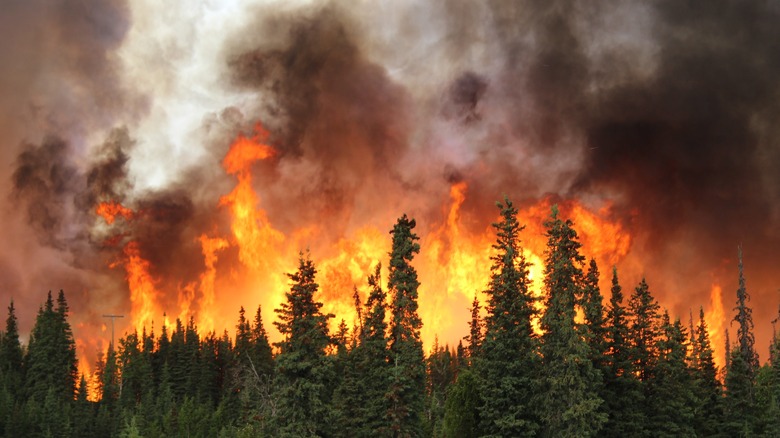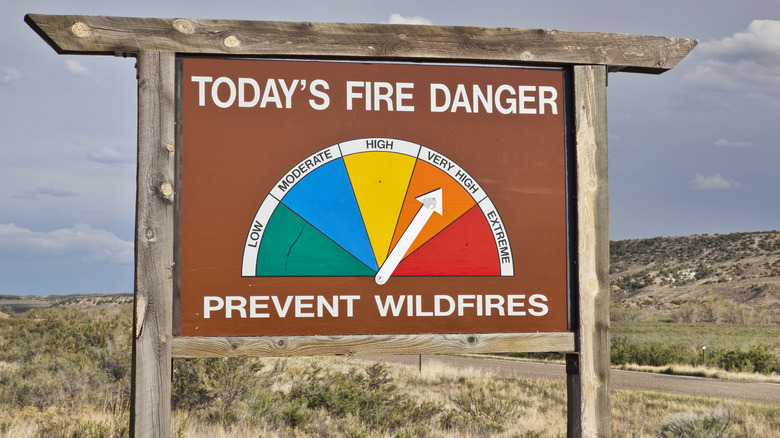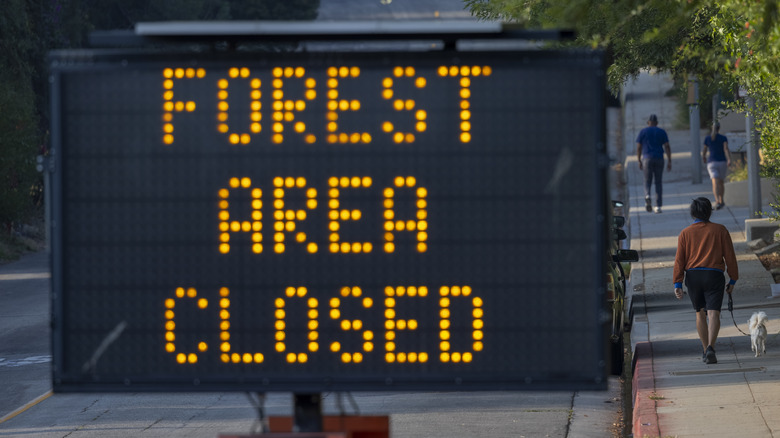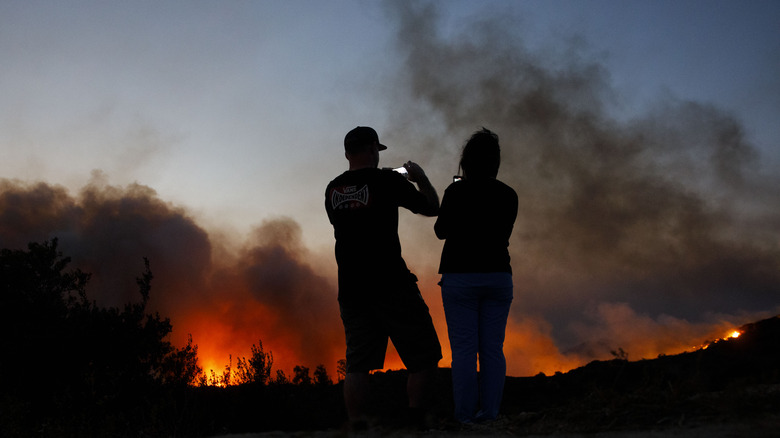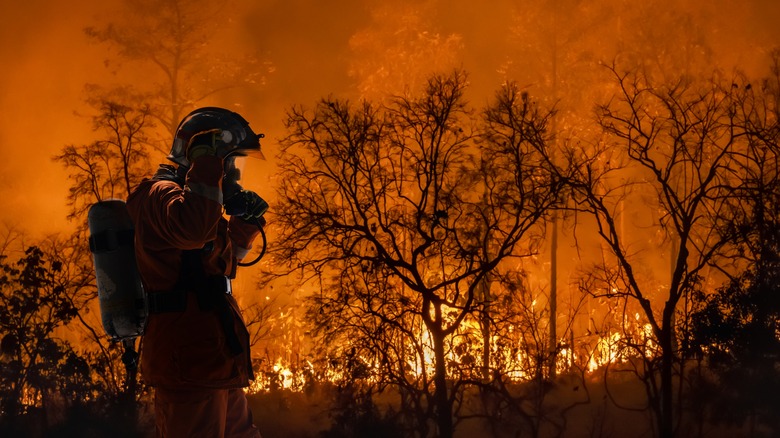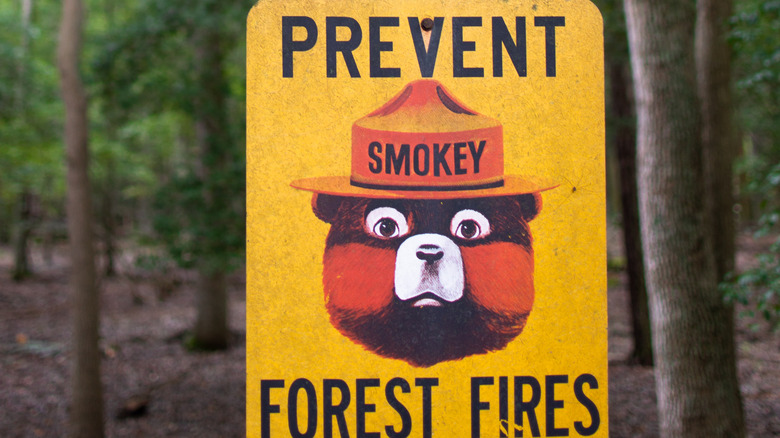Need-To-Know Safety Tips For Vacationing In Wildfire Country
As temperatures rise this summer, so do the chances of wildfires around the world and possibly where you'll be vacationing this year. This is due in part to the wave of atmospheric rivers across the western United States and Europe. Historically drought-prone areas have seen more rainfall and cold weather than many have experienced in their lifetime. As a result, more plants are cropping up. And while more greenery is great for the environment and beneficial for ecosystems, this could be a double-edged sword.
The surplus of vegetation also means that when summer temps hit, these grasses can dry up and become major fuel for wildfires. This prediction is, unfortunately, unfolding in several places around the world this year, and wildfire season is starting. So, it's time to brush up on some safety tips in case you've already got vacation plans for an area that's been impacted or is expected to experience wildfires.
You can't plan for everything, but it doesn't hurt to try
Though the threat of wildfires is very real, we don't suggest hiding inside your house and never leaving again. Instead, our best advice for any area that is prone to wildfires is to do a bit of research in advance and book accommodations in low-risk areas or in places that have evacuation plans in place for guests and local residents.
So, weigh your options and read up on recent news about the area you're headed to. Have they experienced a wildfire or other natural disaster recently? Do they have a history of seasonal wildfires? How have local authorities responded to these events? These are the kinds of questions we don't want to think about when planning our relaxing vacations, but they are unfortunately necessary in this day and age of unpredictable weather events.
Additionally, if you've read that a particular area has experienced severe weather events in the past, you may want to reach out to the hosts at your accommodation. Ask if the home, apartment, or hotel is located in an at-risk area and, if so, what emergency plans they have in place for guests in the event of a wildfire. If you are traveling during the summer, as most people do, this should not come across as a strange question since this is wildfire season.
If a wildfire is happening in your area, here are your first steps to staying safe
If you've been keeping an eye on the news, you may have heard of the recent wildfires in Sicily that have rocked the island. One of the major impacts of these fires was the closure of both major airports on the island in Catania and Palermo, which begs the question: What should you do if you find yourself in a similar situation?
It would be a very rare set of circumstances for you to find yourself confined to an island or facing the possibility of being trapped in an area due to wildfires. However, it can happen. To avoid finding yourself in this dangerous situation, you should always pay close attention to the advice of local authorities.
If you are told to evacuate, leave immediately and do not question why. This is for your safety. While the skies might be clear around you, wildfires can spread at a rate of 14 miles per hour. This doesn't sound that fast in relative terms, but it is an alarming rate for a fire. Additionally, fires can change direction at any time and produce plumes of embers that can blow downwind and start new fires further away. So, check in frequently with local authorities, keep your things packed up and ready to go if there is an ongoing fire emergency, and try to remain calm.
This is what NOT to do in the event of a wildfire
There are three ways a person might react to an emergency or intense situation: fight, flight, or freeze. For any of these reactions, you need to remember to stay calm. In the moment, it may feel like a monumental task to override your natural instincts, but continuing to move and follow directions can ensure not only your own survival but that of your travel companions and emergency responders who are trying to help.
If you're one of those people who don't feel mind-blowing panic at the sight of a wall of fire, don't make this an opportunity to take photos and videos and stare in awe at the fire. You might be compelled to check out what emergency responders are doing, but this is really putting yourself and others in harm's way.
Completely stopping a gas-powered vehicle on a road with a wildfire surrounding you can be dangerous. This is because oxygen levels may be depleted due to the smoke, making it difficult for your car to start again and continue driving. Though we wouldn't recommend driving slow and rubbernecking with an electric vehicle either. Just keep moving! Our last bit of driving advice is to keep your headlights on. You want to be able to see other cars (and other cars to be able to see you) through the smoke.
Help out firefighters and local authorities by following directions
Firefighters are highly regarded for a reason: They're as close to real-world superheroes as you can get. By following directions and working together with them, you are making their jobs just a bit easier and giving yourself the best chance of staying safe and alive. There are far too many horror stories of overconfident homeowners or travelers who have stayed behind to protect their homes or were out in the wilderness at their camping spot instead of following directions.
But it's not always ignorance that can lead someone to disregard the advice of emergency responders or local authorities. Thinking back to the wildfires in Sicily, what should you do if you're in a foreign country and don't speak the language?
You might expect that in an area with a lot of tourists, emergency communications would be delivered in multiple languages. However, you shouldn't rely on that entirely. To make sure you'll always have the most up-to-date information, enroll in the Smart Traveler Enrollment Program or S.T.E.P. This is a travel advisory and alert system for U.S. citizens that provides you with real-time information (in English) about emergencies and potentially dangerous events happening in the country where you are traveling.
Be proactive in your safety, too. If you're not sure what's going on and you haven't received any information from S.T.E.P., ask someone nearby if they speak English and can help you understand the latest emergency information.
Do your part to prevent wildfires in the first place
Fires can start in the most unexpected of ways. A discarded cigarette butt, a backfiring car or hot exhaust pipe, unattended or out-of-control campfires, and fireworks are just a few of the ways wildfires can start. However, this doesn't mean that they're entirely unavoidable. As Smokey Bear says, "Remember... Only you can prevent forest fires!"
If you're camping, check to see if campfires are permitted. During wildfire season, you may not be allowed to have an open fire. If campfires are allowed, always keep an eye on your campfire and make sure it's completely out before you leave. Other advice includes not shooting off fireworks (kind of a no-brainer in wildfire country) and being careful not to drive your car into tall, dry grass to prevent your exhaust pipe from sparking a fire.
In wildfire-prone places, there are typically online resources that keep track of areas that are at risk for wildfires. This is especially true for California, where the Office of the State Fire Marshall has a website that maintains updated maps of Fire Hazard Severity Zones. These are updated frequently and reflect the potential for fires in a given area. If you plan to travel to California or a similarly wildfire-prone area, check out the state or local websites for this information.
